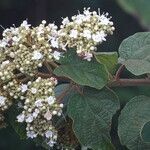Leaves opposite or ternate, petiolate; lamina 3.3–19.5 × 3–14.5 cm, oblong-ovate, ovate or suborbicular, rounded and shortly cuspidate or acuminate at the apex, broadly cuneate to subtruncate or cordate at the base, entire or rarely irregularly crenate, discolorous, sparsely pubescent above with patent acicular hairs, ± pubescent-velutinous beneath with sessile spherical translucent to pale yellowish or reddish glands; petiole 0.8–10.5 cm long, articulate above the base, the basal part in stronger branches woody even before the fall of the leaf lamina.
Inflorescences axillary and terminal forming dense corymbose panicles of cymes 5–20 cm in diameter, sometimes with cymes also in the axils of the upper leaves; cymes many-flowered; peduncles of cymes somewhat thick, spreading or erect-spreading, the lower peduncles 4.5–6 cm (or more?) long; pedicels 0–3 mm long; bracts 5–10 mm long, linear-spathulate.
Stems with paired truncate projections or stout recurved hook-like persistent woody petiole bases; young shoots and branches densely tomentose-pubescent with soft crisped yellow-orange or ferruginous to bright red hairs, a similar indumentum also present on the petiole, inflorescences and calyces; older stems 4-angled, subglabrous.
Corolla white or creamy; tube 8–10 mm long, glabrous or nearly so; lobes 3–4 × 3–4 mm, elliptic-oblong, ciliate and pubescent outside with sessile spherical, reddish, sparse, minute glands on the outside.
Fruit 10–12 mm long and 9 mm wide, black, surrounded by the persistent, obtusely lobed, sitting in a cup-like calyx c. 12 mm in diameter.
An erect shrub 1.5–4.5 m high or a scrambling shrub with scandent stems up to 10.5 m long, or a tree up to 8 m tall.
Calyx campanulate, 3–4.5 mm long; lobes 1.5–2 mm long, triangular.
Style and stamens exserted for c. 8 mm.
Flowers sweet-scented.


